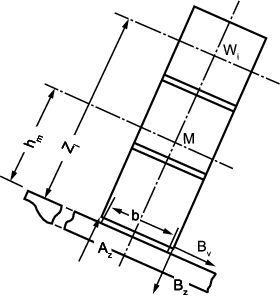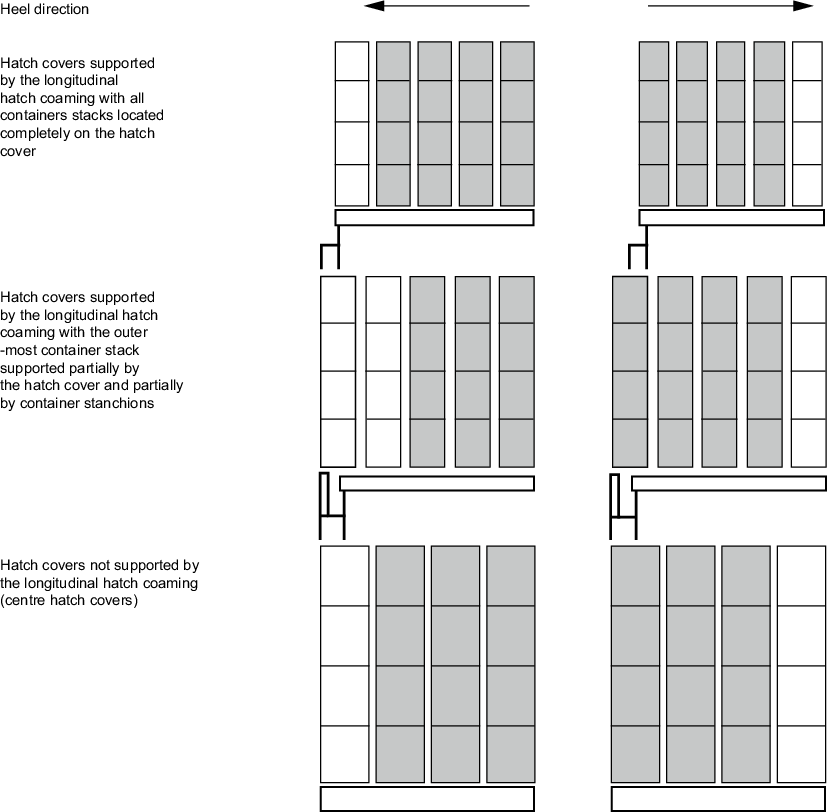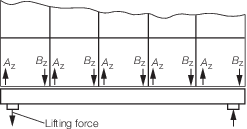
Section
11 Hatch covers

11.1 General
11.1.2 The
primary structure of hatch covers normally consists of an arrangement
of deep beams and girders including hatch cover top plating.
11.1.3 For
hatch covers subjected to point loads from containers, the primary
structure scantlings are to be verified by direct calculation in accordance
with Pt 4, Ch 8, 11.2 Direct calculations.

11.2 Direct calculations
11.2.1 Direct
calculations are to be based on 2D or 3D finite element analysis.
Simplified boundary constraints may be applied in the modelling, provided
this does not compromise the overall structural response.
11.2.3 The load P in kN, applied at each corner of a container stack, and resulting from
heave and pitch (i.e. ship in upright condition) is to be determined as follows:
|
P |
= |
 |
where:
11.2.4 The loads applied at each corner of a container stack, and resulting from
heave, pitch, and the ship's rolling motion (i.e. ship in heeled condition) are to be
determined as follows, see
Figure 8.11.1 Forces due to container
loads:
The loads due to single forces resulting from heave and pitch are also to be considered,
as defined in Pt 3, Ch 11, 2.3 Load model 2.3.5, where
|
a
v
|
= |
acceleration addition according to Pt 3, Ch 11, 2.3 Load model 2.3.4
|
|
b
|
= |
distance between midpoints of foot points, in metres |
|
h
m
|
= |
designed height of centre of gravity of stack above hatch cover top,
in metres, may be calculated as weighted mean value of the stack, where the centre
of gravity of each tier is assumed to be located at the centre of each container, |
| = |
 |
|
Zi |
= |
distance from the hatch cover top to the centre of ith
container, in metres |
|
mi |
= |
mass of ith container, in t |
|
A
z, B
z
|
= |
support forces in z-direction at the forward and aft stack corners,
in kN |
|
B
y
|
= |
support force in y-direction at the forward and aft stack corners, in
kN |
|
M
|
= |
maximum designed mass of container stack, in t. |
When strength of the hatch cover structure is assessed by grillage analysis
according to Pt 3, Ch 11, 2.11 Buckling strength of hatch cover structures
hm and zi need to be taken above the hatch cover
supports. Force By does not need to be considered in this case. Values of
Az and Bz applied for the assessment of hatch
cover strength are to be shown in the drawings of the hatch covers. It is recommended
that container loads as calculated above are considered as maximum load limits for foot
point loads of container stacks in the calculations of cargo securing (container
lashings).

Figure 8.11.1 Forces due to container
loads
11.2.5 Load cases defined in Pt 4, Ch 8, 11.2 Direct calculations 11.2.3 and Pt 4, Ch 8, 11.2 Direct calculations 11.2.4 are also to be considered for partial
non-homogeneous loading which may occur in practice, e.g. where specified container
stack places are empty. For each hatch cover, the heel directions as shown in Figure 8.11.2 Partial loading of a container
hatch cover are to be considered.
The load case partial loading of container hatch covers can be
evaluated using a simplified approach, where the hatch cover is loaded without the
outermost stacks that are located completely on the hatch cover. If there are additional
stacks that are supported partially by the hatch cover and partially by container
stanchions, then the loads from these stacks are also to be neglected. See Figure 8.11.2 Partial loading of a container
hatch cover. In addition, in order to consider the maximum
loads in the vertical hatch cover supports, the case where only the stack locations that
are partially supported by the hatch cover and partially supported by container
stanchions are left empty is to be assessed. Partial load cases where container stack
positions other than those shown in Figure 8.11.2 Partial loading of a container
hatch cover are left empty are to be considered.

Figure 8.11.2 Partial loading of a container
hatch cover
11.2.6 The securing devices of hatch covers, onto which cargo is to be lashed, are
to be designed for the lifting forces resulting from loads according to Pt 4, Ch 8, 11.2 Direct calculations 11.2.4, see
Figure 8.11.2 Partial loading of a container
hatch cover. Unsymmetrical loadings, which may occur in
practice, are to be considered. Under these loadings, the equivalent stress in the
securing devices is not to exceed:
where:
|
kl |
= |
 |
|
σo |
= |
minimum yield stress, in N/mm2, of the material but not
to be taken greater than 0,7 σm
|
|
σm |
= |
minimum specified tensile strength, in N/mm2, of the material |
|
e |
= |
0,75 for σo > 235 N/mm2 |
| = |
1,0 for σo ≤ 235 N/mm2 |
Special consideration may be given for the omission of anti-lifting devices
for non-weathertight hatch covers.
The partial load cases given in Pt 4, Ch 8, 11.2 Direct calculations 11.2.5 may not cover all unsymmetrical loadings, critical
for hatch cover lifting.

Figure 8.11.3 Lifting forces at a hatch cover
11.2.7 Where hatch covers are arranged for carrying containers and mixed stowage
is allowed, i.e. a 40’ container stowed on top of two 20’ containers, the foot point
forces at the fore and aft end of the hatch cover are not to be higher than those
resulting from the design stack weight for 40’ containers, and the foot point forces at
the middle of the cover are not to be higher than those resulting from the design stack
weight for 20’ containers. Particular attention is to be paid to the deflections of
hatch covers. Furthermore, the possible contact of deflected hatch covers with in-hold
cargo is to be considered.

11.3 Dispensation of weathertight gaskets
11.3.1 For
hatch covers of cargo holds solely for the transport of containers,
upon request by the Owners and subject to compliance with the requirements
of this Section, the fitting of weathertight gaskets according to Pt 3, Ch 11, 4.4 Packing material may be dispensed
with.
11.3.2 The
hatchway coamings are not to be less than 600 mm in height.
11.3.3 The
exposed deck on which the hatch covers are located is situated above
a depth H(x). H(x) is to be shown to comply
with the following criteria:
|
H(x)
|
= |
≥ T
fb + f
b + h,
in metres
|
where
|
T
fb
|
= |
draught, in metres, corresponding to the assigned summer load
line |
|
f
b
|
= |
minimum required freeboard, in metres, determined in accordance
with ICLL Reg. 28 as modified by further regulations, as applicable |
|
h
|
= |
4,6
m for  ≤ 0,75 ≤ 0,75
|
|
|
= |
6,9 m for  > 0,75 > 0,75
|
11.3.4 Labyrinths,
gutter bars or equivalents are to be fitted proximate to the edges
of each panel in way of the coamings. The clear profile of these openings
is to be kept as small as possible.
11.3.5 Where
a hatch is covered by several hatch cover panels, the clear opening
of the gap in between the panels is to be not wider than 50 mm.
11.3.6 The
labyrinths and gaps between hatch cover panels shall be considered
as unprotected openings with respect to the requirements of intact
and damage stability calculations.
11.3.7 Bilge
alarms are to be provided in each hold fitted with non-weathertight
covers.

11.4 Omission of hatch covers
|